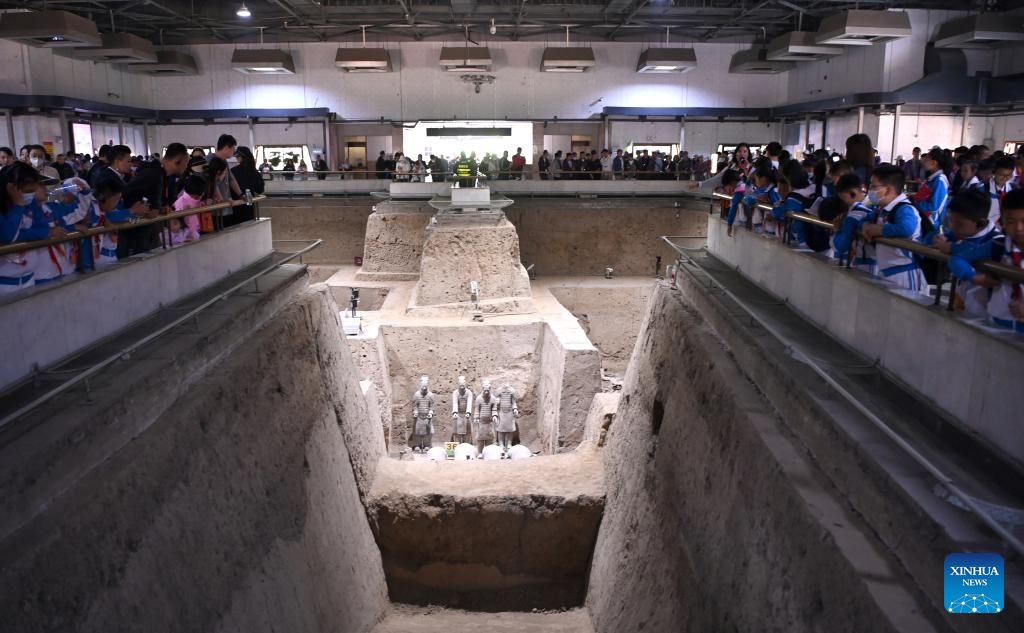
People visit pit No.3 of the Emperor Qinshihuang's Mausoleum Site Museum in Xi'an, northwest China's Shaanxi Province, April 26, 2023. Xi'an, a city with over 3,100 years of history, served as the capital for 13 dynasties in Chinese history. It is also home to the world-renowned Terracotta warriors.
Discovered in 1974 and listed as a world heritage site by UNESCO in 1987, the army of Terracotta Warriors was built by Emperor Qinshihuang of the Qin Dynasty (221 B.C.-207 B.C.), who unified China for the first time.
The Emperor Qinshihuang's Mausoleum Site Museum, housing the famous army of Terracotta Warriors, has received over 100 million visits up to now. (Xinhua/Liu Xiao)
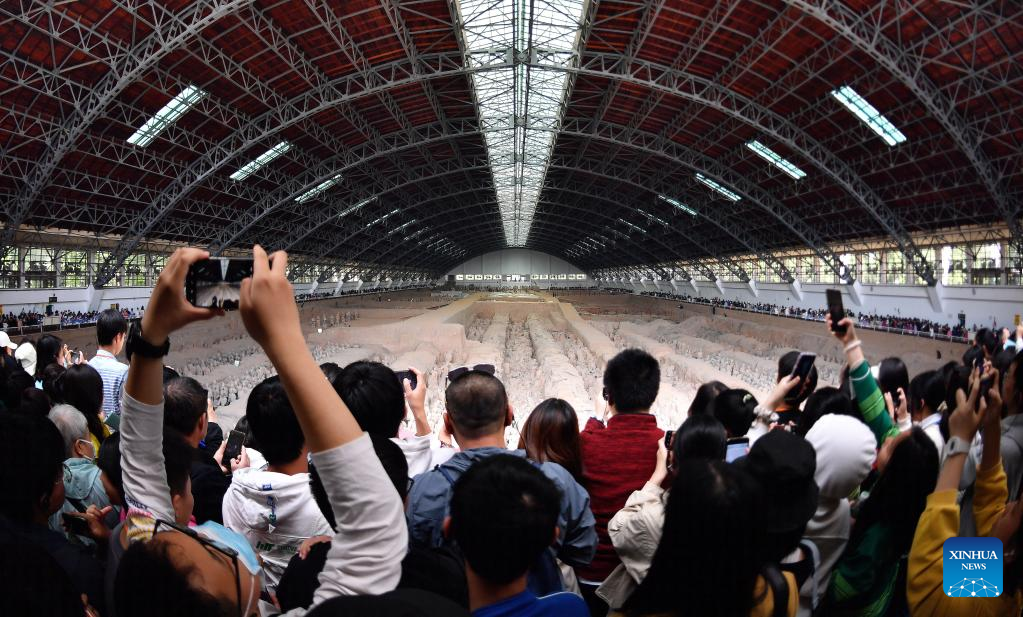
People visit pit No.1 of the Emperor Qinshihuang's Mausoleum Site Museum in Xi'an, northwest China's Shaanxi Province, April 26, 2023. Xi'an, a city with over 3,100 years of history, served as the capital for 13 dynasties in Chinese history. It is also home to the world-renowned Terracotta warriors.
Discovered in 1974 and listed as a world heritage site by UNESCO in 1987, the army of Terracotta Warriors was built by Emperor Qinshihuang of the Qin Dynasty (221 B.C.-207 B.C.), who unified China for the first time.
The Emperor Qinshihuang's Mausoleum Site Museum, housing the famous army of Terracotta Warriors, has received over 100 million visits up to now. (Xinhua/Liu Xiao)

People visit pit No.1 of the Emperor Qinshihuang's Mausoleum Site Museum in Xi'an, northwest China's Shaanxi Province, April 26, 2023. Xi'an, a city with over 3,100 years of history, served as the capital for 13 dynasties in Chinese history. It is also home to the world-renowned Terracotta warriors.
Discovered in 1974 and listed as a world heritage site by UNESCO in 1987, the army of Terracotta Warriors was built by Emperor Qinshihuang of the Qin Dynasty (221 B.C.-207 B.C.), who unified China for the first time.
The Emperor Qinshihuang's Mausoleum Site Museum, housing the famous army of Terracotta Warriors, has received over 100 million visits up to now. (Xinhua/Liu Xiao)

Staff members work at the pit No.2 of the Emperor Qinshihuang's Mausoleum Site Museum in Xi'an, northwest China's Shaanxi Province, April 26, 2023. Xi'an, a city with over 3,100 years of history, served as the capital for 13 dynasties in Chinese history. It is also home to the world-renowned Terracotta warriors.
Discovered in 1974 and listed as a world heritage site by UNESCO in 1987, the army of Terracotta Warriors was built by Emperor Qinshihuang of the Qin Dynasty (221 B.C.-207 B.C.), who unified China for the first time.
The Emperor Qinshihuang's Mausoleum Site Museum, housing the famous army of Terracotta Warriors, has received over 100 million visits up to now. (Xinhua/Liu Xiao)
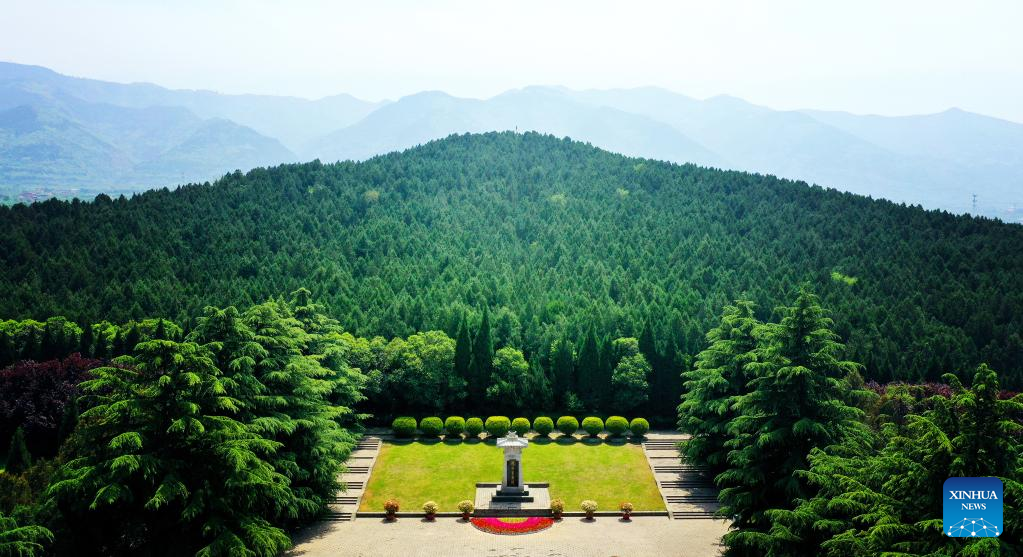
This aerial photo taken on April 26, 2023 shows a view of the mausoleum of the Emperor Qinshihuang of the Qin Dynasty in Xi'an, northwest China's Shaanxi Province. Xi'an, a city with over 3,100 years of history, served as the capital for 13 dynasties in Chinese history. It is also home to the world-renowned Terracotta warriors.
Discovered in 1974 and listed as a world heritage site by UNESCO in 1987, the army of Terracotta Warriors was built by Emperor Qinshihuang of the Qin Dynasty (221 B.C.-207 B.C.), who unified China for the first time.
The Emperor Qinshihuang's Mausoleum Site Museum, housing the famous army of Terracotta Warriors, has received over 100 million visits up to now. (Xinhua/Liu Xiao)
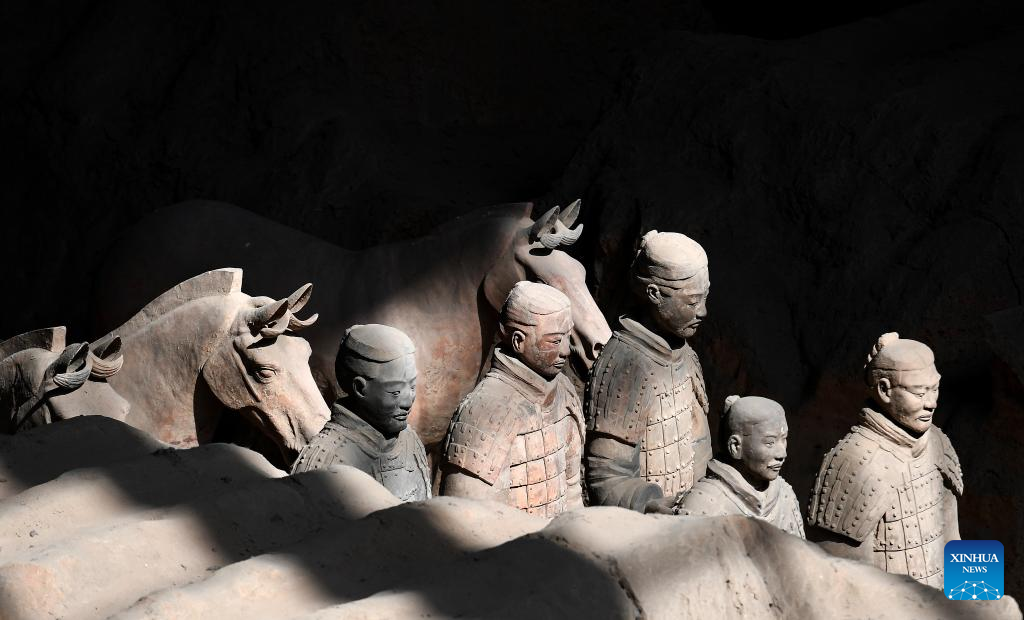
This photo taken on April 26, 2023 shows terracotta warriors at the pit No.1 of the Emperor Qinshihuang's Mausoleum Site Museum in Xi'an, northwest China's Shaanxi Province. Xi'an, a city with over 3,100 years of history, served as the capital for 13 dynasties in Chinese history. It is also home to the world-renowned Terracotta warriors.
Discovered in 1974 and listed as a world heritage site by UNESCO in 1987, the army of Terracotta Warriors was built by Emperor Qinshihuang of the Qin Dynasty (221 B.C.-207 B.C.), who unified China for the first time.
The Emperor Qinshihuang's Mausoleum Site Museum, housing the famous army of Terracotta Warriors, has received over 100 million visits up to now. (Photo by Zou Jingyi/Xinhua)
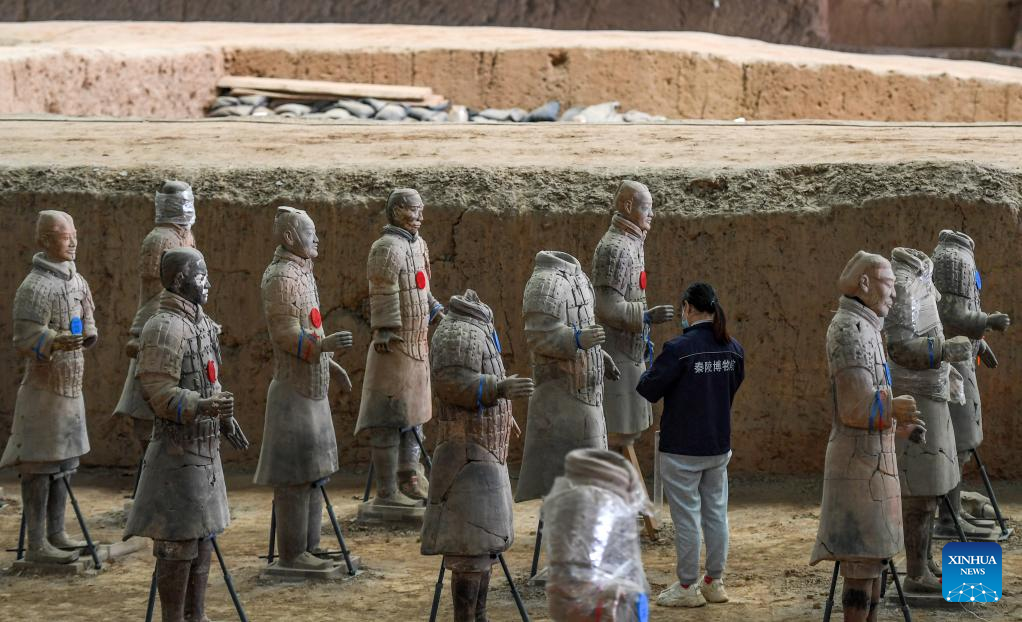
A staff member repairs a terracotta warrior at the pit No.1 of the Emperor Qinshihuang's Mausoleum Site Museum in Xi'an, northwest China's Shaanxi Province, April 26, 2023. Xi'an, a city with over 3,100 years of history, served as the capital for 13 dynasties in Chinese history. It is also home to the world-renowned Terracotta warriors.
Discovered in 1974 and listed as a world heritage site by UNESCO in 1987, the army of Terracotta Warriors was built by Emperor Qinshihuang of the Qin Dynasty (221 B.C.-207 B.C.), who unified China for the first time.
The Emperor Qinshihuang's Mausoleum Site Museum, housing the famous army of Terracotta Warriors, has received over 100 million visits up to now. (Photo by Zou Jingyi/Xinhua)
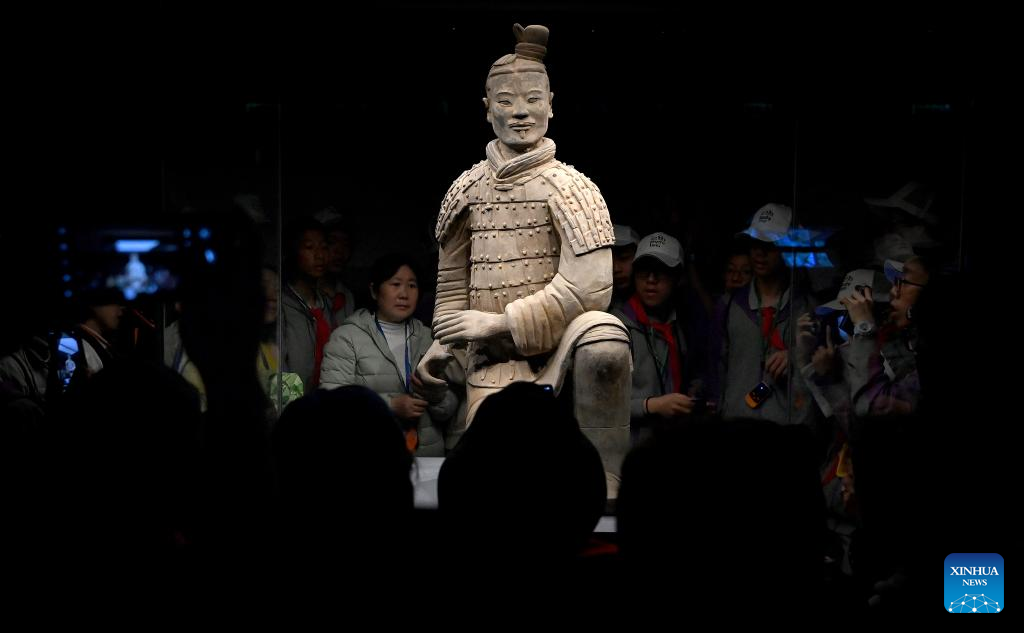
People visit the Emperor Qinshihuang's Mausoleum Site Museum in Xi'an, northwest China's Shaanxi Province, April 26, 2023. Xi'an, a city with over 3,100 years of history, served as the capital for 13 dynasties in Chinese history. It is also home to the world-renowned Terracotta warriors.
Discovered in 1974 and listed as a world heritage site by UNESCO in 1987, the army of Terracotta Warriors was built by Emperor Qinshihuang of the Qin Dynasty (221 B.C.-207 B.C.), who unified China for the first time.
The Emperor Qinshihuang's Mausoleum Site Museum, housing the famous army of Terracotta Warriors, has received over 100 million visits up to now. (Xinhua/Liu Xiao)
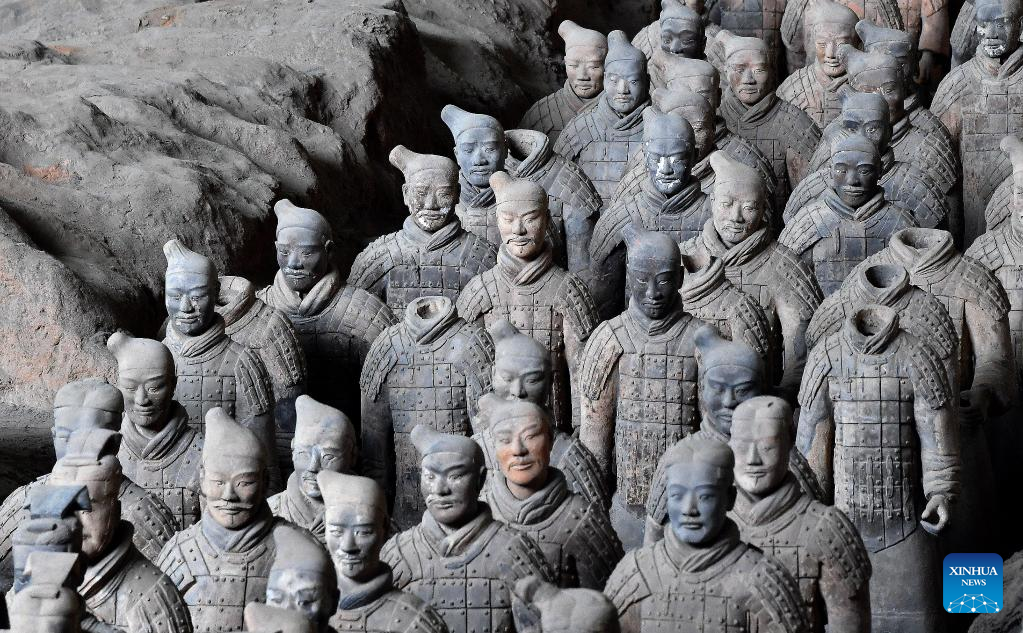
This photo taken on April 26, 2023 shows terracotta warriors at the pit No.1 of the Emperor Qinshihuang's Mausoleum Site Museum in Xi'an, northwest China's Shaanxi Province. Xi'an, a city with over 3,100 years of history, served as the capital for 13 dynasties in Chinese history. It is also home to the world-renowned Terracotta warriors.
Discovered in 1974 and listed as a world heritage site by UNESCO in 1987, the army of Terracotta Warriors was built by Emperor Qinshihuang of the Qin Dynasty (221 B.C.-207 B.C.), who unified China for the first time.
The Emperor Qinshihuang's Mausoleum Site Museum, housing the famous army of Terracotta Warriors, has received over 100 million visits up to now. (Xinhua/Liu Xiao)

A staff member repairs a terracotta warrior at the pit No.1 of the Emperor Qinshihuang's Mausoleum Site Museum in Xi'an, northwest China's Shaanxi Province, April 26, 2023. Xi'an, a city with over 3,100 years of history, served as the capital for 13 dynasties in Chinese history. It is also home to the world-renowned Terracotta warriors.
Discovered in 1974 and listed as a world heritage site by UNESCO in 1987, the army of Terracotta Warriors was built by Emperor Qinshihuang of the Qin Dynasty (221 B.C.-207 B.C.), who unified China for the first time.
The Emperor Qinshihuang's Mausoleum Site Museum, housing the famous army of Terracotta Warriors, has received over 100 million visits up to now. (Photo by Zou Jingyi/Xinhua)
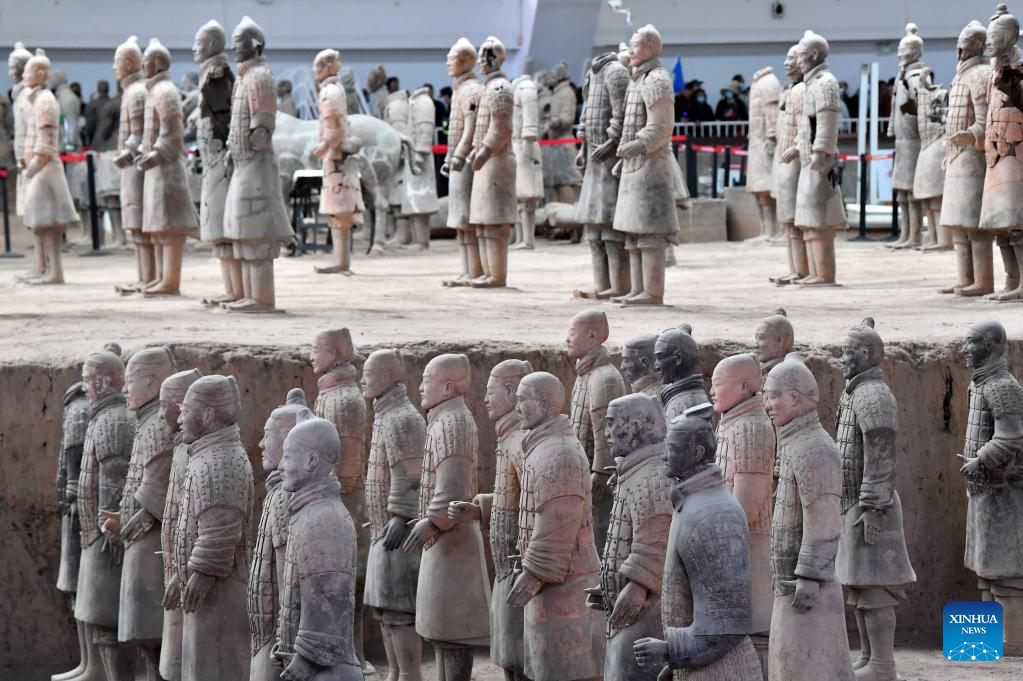
This photo taken on April 26, 2023 shows terracotta warriors at the pit No.1 of the Emperor Qinshihuang's Mausoleum Site Museum in Xi'an, northwest China's Shaanxi Province. Xi'an, a city with over 3,100 years of history, served as the capital for 13 dynasties in Chinese history. It is also home to the world-renowned Terracotta warriors.
Discovered in 1974 and listed as a world heritage site by UNESCO in 1987, the army of Terracotta Warriors was built by Emperor Qinshihuang of the Qin Dynasty (221 B.C.-207 B.C.), who unified China for the first time.
The Emperor Qinshihuang's Mausoleum Site Museum, housing the famous army of Terracotta Warriors, has received over 100 million visits up to now. (Xinhua/Liu Xiao)
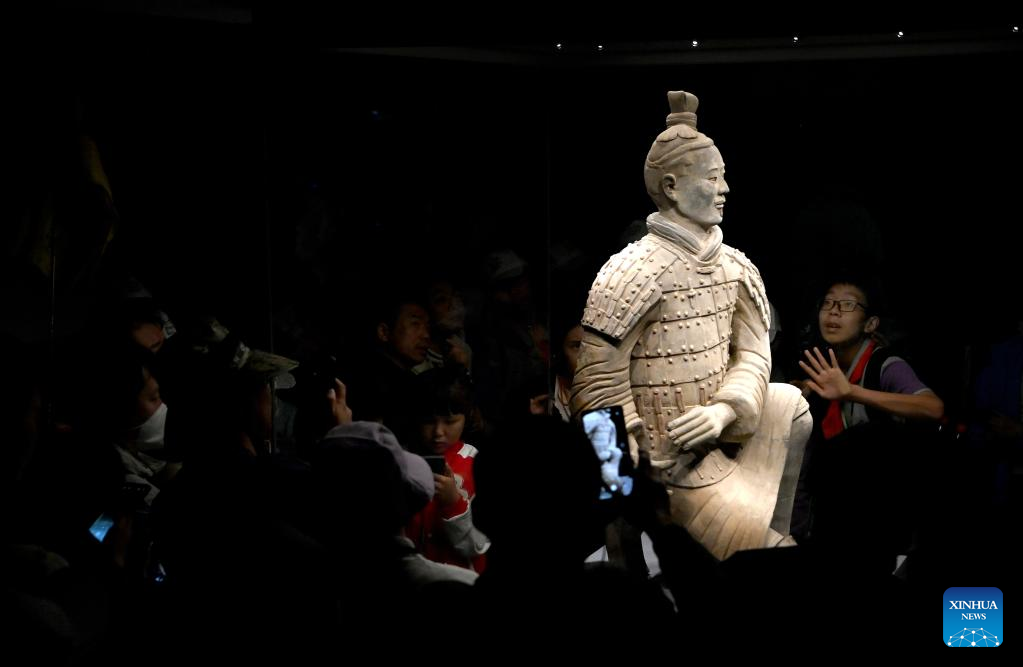
People visit the Emperor Qinshihuang's Mausoleum Site Museum in Xi'an, northwest China's Shaanxi Province, April 26, 2023. Xi'an, a city with over 3,100 years of history, served as the capital for 13 dynasties in Chinese history. It is also home to the world-renowned Terracotta warriors.
Discovered in 1974 and listed as a world heritage site by UNESCO in 1987, the army of Terracotta Warriors was built by Emperor Qinshihuang of the Qin Dynasty (221 B.C.-207 B.C.), who unified China for the first time.
The Emperor Qinshihuang's Mausoleum Site Museum, housing the famous army of Terracotta Warriors, has received over 100 million visits up to now. (Xinhua/Liu Xiao)
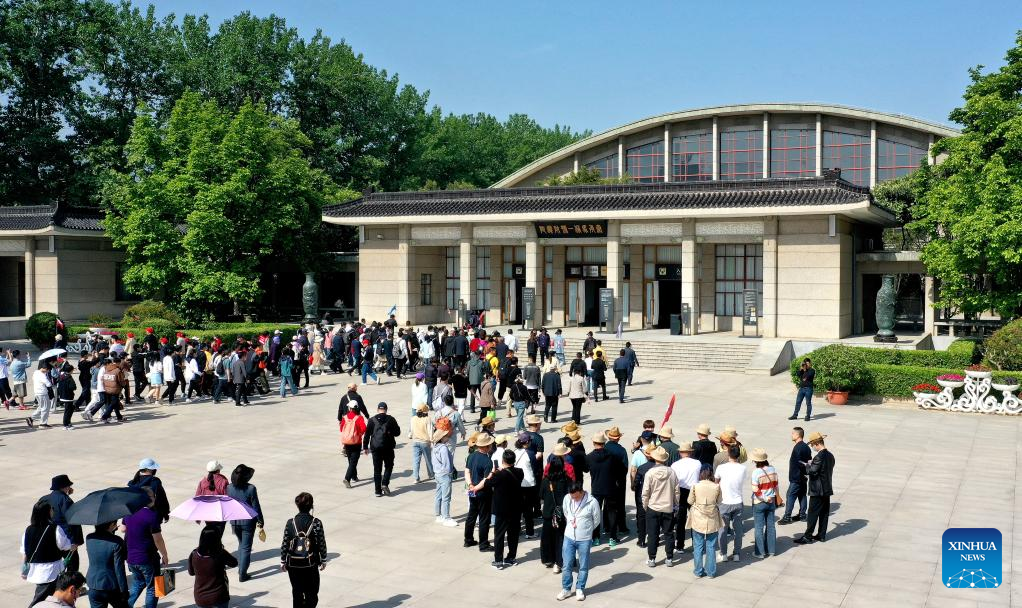
This aerial photo taken on April 26, 2023 shows tourists outside the pit No.1 of the Emperor Qinshihuang's Mausoleum Site Museum in Xi'an, northwest China's Shaanxi Province. Xi'an, a city with over 3,100 years of history, served as the capital for 13 dynasties in Chinese history. It is also home to the world-renowned Terracotta warriors.
Discovered in 1974 and listed as a world heritage site by UNESCO in 1987, the army of Terracotta Warriors was built by Emperor Qinshihuang of the Qin Dynasty (221 B.C.-207 B.C.), who unified China for the first time.
The Emperor Qinshihuang's Mausoleum Site Museum, housing the famous army of Terracotta Warriors, has received over 100 million visits up to now. (Xinhua/Liu Xiao)
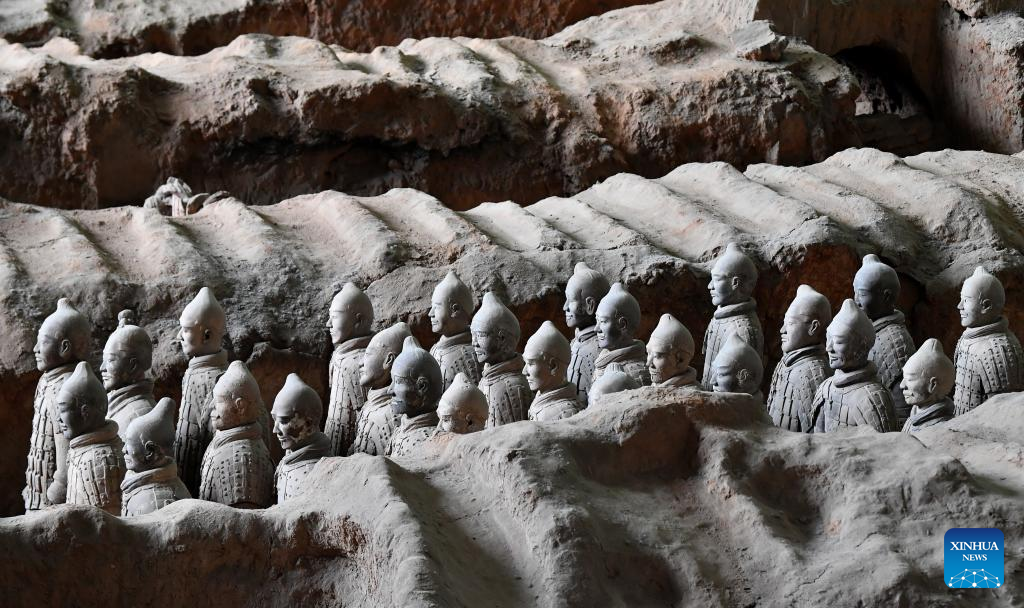
This photo taken on April 26, 2023 shows terracotta warriors at the pit No.1 of the Emperor Qinshihuang's Mausoleum Site Museum in Xi'an, northwest China's Shaanxi Province. Xi'an, a city with over 3,100 years of history, served as the capital for 13 dynasties in Chinese history. It is also home to the world-renowned Terracotta warriors.
Discovered in 1974 and listed as a world heritage site by UNESCO in 1987, the army of Terracotta Warriors was built by Emperor Qinshihuang of the Qin Dynasty (221 B.C.-207 B.C.), who unified China for the first time.
The Emperor Qinshihuang's Mausoleum Site Museum, housing the famous army of Terracotta Warriors, has received over 100 million visits up to now. (Xinhua/Liu Xiao)
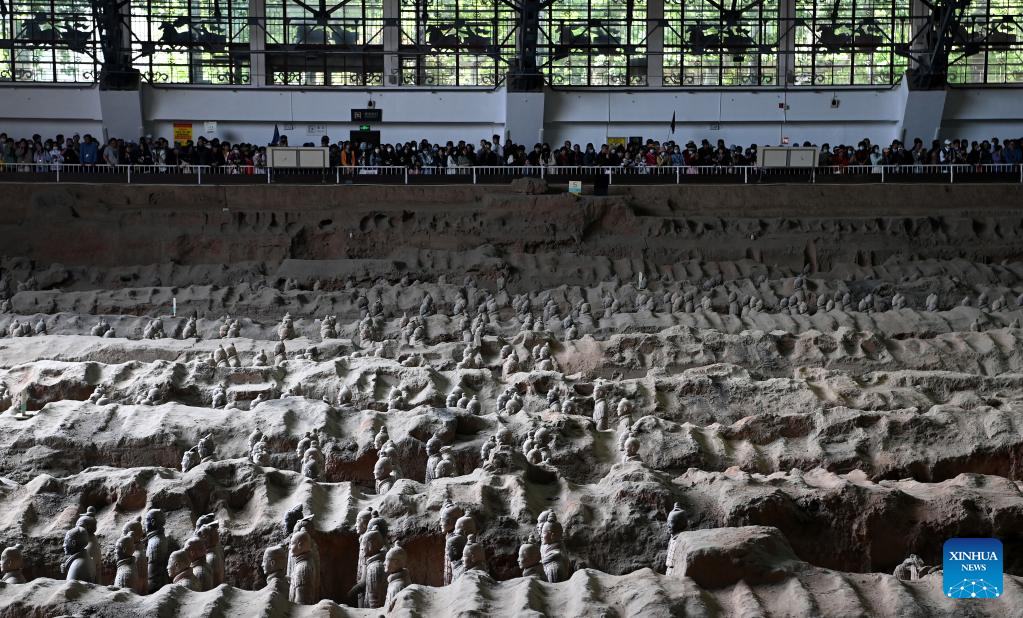
People visit pit No.1 of the Emperor Qinshihuang's Mausoleum Site Museum in Xi'an, northwest China's Shaanxi Province, April 26, 2023. Xi'an, a city with over 3,100 years of history, served as the capital for 13 dynasties in Chinese history. It is also home to the world-renowned Terracotta warriors.
Discovered in 1974 and listed as a world heritage site by UNESCO in 1987, the army of Terracotta Warriors was built by Emperor Qinshihuang of the Qin Dynasty (221 B.C.-207 B.C.), who unified China for the first time.
The Emperor Qinshihuang's Mausoleum Site Museum, housing the famous army of Terracotta Warriors, has received over 100 million visits up to now. (Xinhua/Liu Xiao)
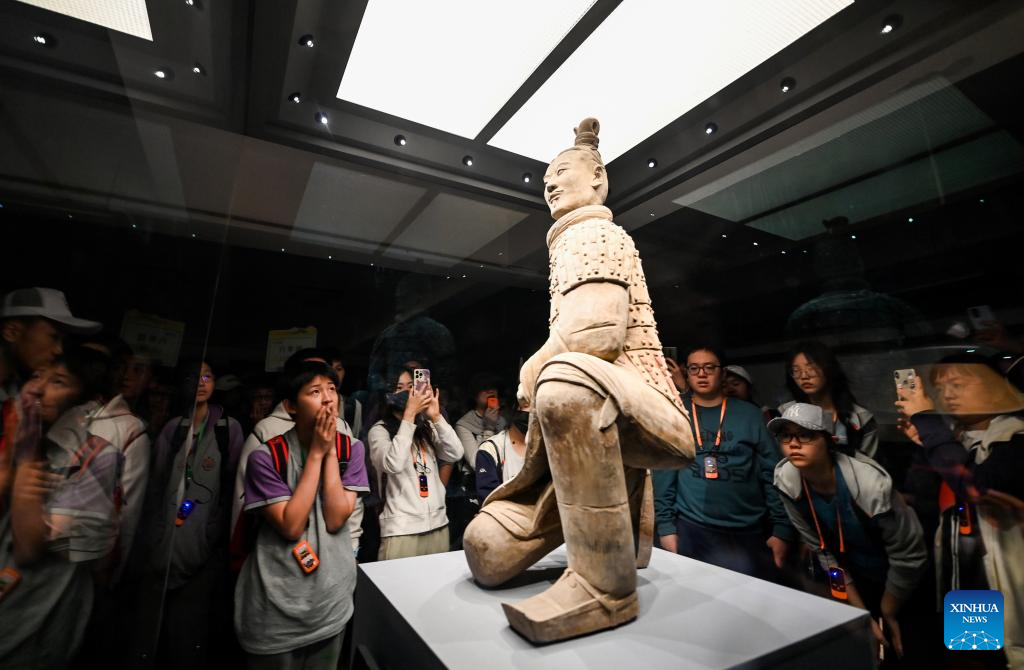
People visit the Emperor Qinshihuang's Mausoleum Site Museum in Xi'an, northwest China's Shaanxi Province, April 26, 2023. Xi'an, a city with over 3,100 years of history, served as the capital for 13 dynasties in Chinese history. It is also home to the world-renowned Terracotta warriors.
Discovered in 1974 and listed as a world heritage site by UNESCO in 1987, the army of Terracotta Warriors was built by Emperor Qinshihuang of the Qin Dynasty (221 B.C.-207 B.C.), who unified China for the first time.
The Emperor Qinshihuang's Mausoleum Site Museum, housing the famous army of Terracotta Warriors, has received over 100 million visits up to now. (Photo by Zou Jingyi/Xinhua)



